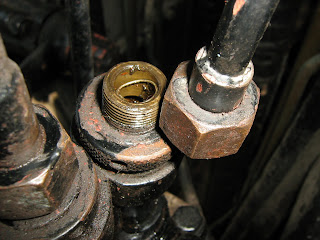Roger Slade of CSP models has been beavering away on an etched brass model Radstock Sentinel loco and it has now come to fruition. It is a superb model as is obvious from the pictures.
 |
| CSP Radstock Sentinel Model |
Roger's announcement (slightly edited for this context) is below:
S&DJR/LMS/BR. Sentinel 0-4-0T Steam Shunter.
Dorset based CSP Models in Dorchester have launched their long awaited 4mm etched brass kit for the Sentinel Shunter.
The project was started 2 years ago by CSP and Zenith Works. It was a challenge to produce an accurate and buildable kit for this quite complex locomotive. It wasn’t just to be a model but a lasting record of what these delightful little locos were.
With the priceless help of Andy Chapman and his long term lover “Joyce”, a set of somewhat doubtful works drawings, a fistful of photographic evidence and a great deal of optimism we set to work.
After a number of visits to MSN with a ruler and a camera we had our first set of drawings. A test etch was produced in November 2010 and a prototype produced. It looked OK but we found a number of inaccuracies. Andy let me see all the boiler fittings and with a set of drawings we decided to add a fully detailed boiler, ashpan, superheater and chimneys. How they went together was another matter but with the help of one of our most enthusiastic customers, Richard Roper of Emborough, who sketched a working model of the chimneys, we managed to get it right, we hope!!!!!
The chassis is driven by a “High Level” Gearbox through a series of spur gears to all 4 wheels. With the chassis weighted by the ballast in the boiler and ballast in the front chain box, yes it even has that and an etched chain! Maximum adhesion has been achieved.
The chassis, “00” or EM, with provision for compensation for P4, is Nickel Silver and the body a fusion of Nickel Silver and Brass. All the fittings are lost wax brass. The kit comes complete with wheels, gearbox, gears and motor. It also has etched number plates for both LMS and BR eras. All that is required to produce your own little masterpiece is hours of patience, some black spray and some decals.
There is a comprehensive, 16 page set of instructions with exploded diagrams of every stage of the construction. It is an eminently achievable project for people with average skills of kit construction. The cost of the complete kit is £135.00 + £5. 50 p&p; we can supply the basic kit for £95.00 for those that have their own ideas for motorising it.
We hope that it be well received by all S&D modellers. It has been a very difficult project to bring to fruition but we are happy with the outcome. We hope you are too.
A similar kit for “Joyce” in 4 & 7mm is nearly finished and will be available early in 2012.
It's very kind of Roger to acknowledge my assistance in the project. More so, I'm really pleased that he is working on a Joyce variation.
More pictures of this superb model are here below:
 |
| Incredible boiler detail! |

















































